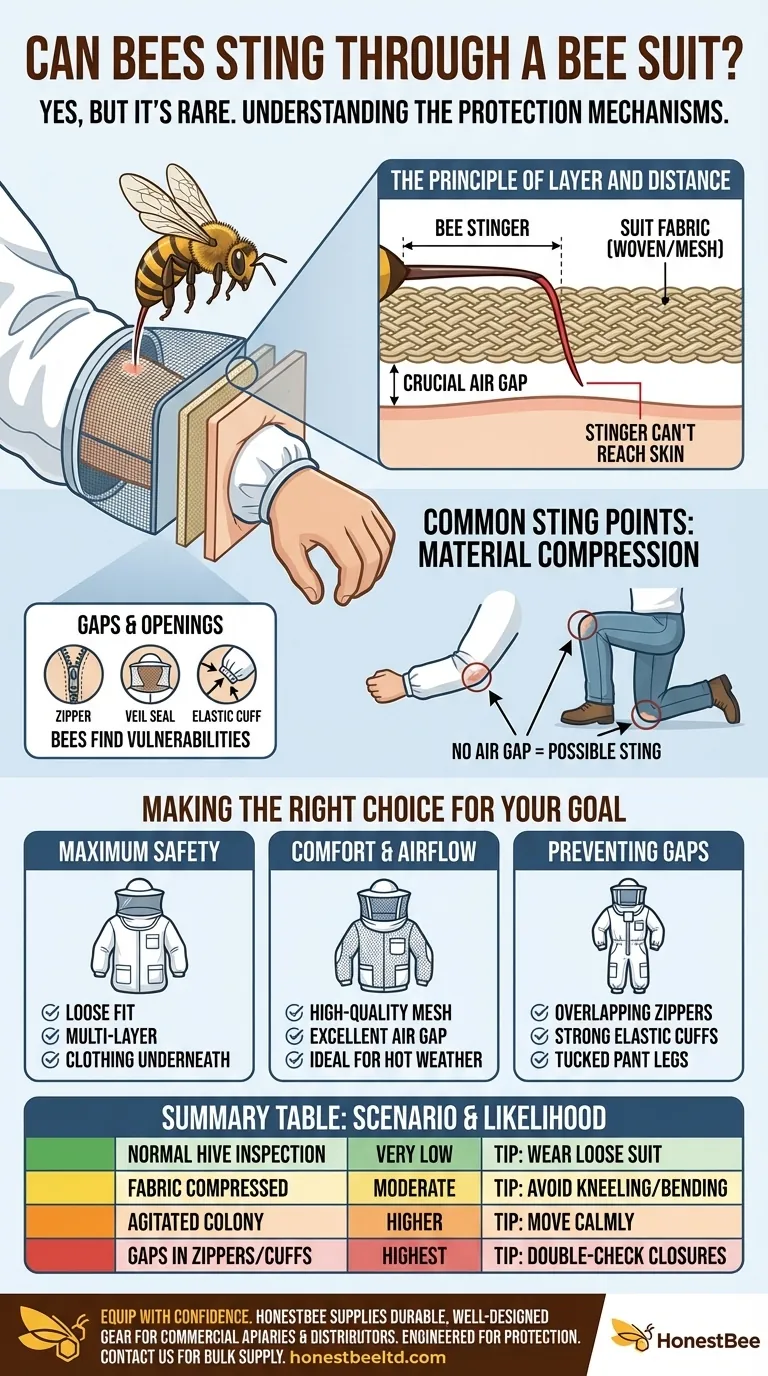Yes, in rare circumstances, a bee can sting through a bee suit. While modern bee suits offer exceptional protection and drastically reduce the likelihood of being stung, they are not 100% sting-proof. The goal of a suit is not to make you invincible, but to provide a robust layer of defense that makes stings a highly uncommon event rather than a certainty.
A bee suit should be viewed as a critical safety system, not an impenetrable shield. Its effectiveness depends on three factors: the quality of the material, the fit of the suit, and the calm, deliberate actions of the beekeeper wearing it.

How a Bee Suit Actually Protects You
A bee suit's protection isn't based on being a hard armor, but on principles of thickness and separation. Understanding this mechanism helps you use it more effectively.
The Principle of Layer and Distance
A bee's stinger (an ovipositor) has a finite length. The primary goal of a bee suit is to create a barrier of fabric and, crucially, an air gap between the material and your skin.
If the fabric is thick enough or positioned far enough from your body, the stinger simply cannot reach you even if it penetrates the outer material.
Material Weave and Thickness
Most beekeeping suits are made from thick, woven cotton, poly-cotton blends, or layered mesh fabrics. The tight weave of these materials is difficult for a bee's stinger to puncture in the first place.
Ventilated suits use multiple layers of mesh, creating a built-in air gap that offers excellent protection while also improving comfort.
Understanding the Points of Failure
While a suit provides comprehensive protection, stings typically occur when one of its defensive layers is compromised. Knowing these weak points is the key to preventing stings.
Material Compression
The most common way a stinger penetrates a suit is when the fabric is pulled tight against the skin. This often happens at the knees when you kneel or at the elbows when you bend your arms.
This compression eliminates the protective air gap, giving a determined bee a direct opportunity to sting through the fabric.
Gaps and Openings
An agitated bee is an expert at finding small vulnerabilities. The most common entry points are not through the fabric itself, but through gaps in the suit's assembly.
Pay close attention to zippers, the seal between your veil and the suit collar, and the elastic cuffs at your wrists and ankles. A single bee inside your veil is a much greater problem than one outside it.
The Role of an Agitated Colony
A calm colony is unlikely to test your suit's defenses. However, if the bees become agitated or defensive, they will be far more persistent in their attempts to sting.
Actions like dropping a hive tool, moving too quickly, or crushing a bee can release alarm pheromones, escalating the colony's defensive response and increasing the chances of them probing your suit for weaknesses.
Making the Right Choice for Your Goal
Selecting and wearing a suit correctly is your most important step in hive safety. Your approach should match your level of interaction with the bees.
- If your primary focus is maximum safety: Invest in a full, multi-layer ventilated suit and ensure it is loose-fitting. Always wear clothing underneath and double-check that every zipper and seal is secure before approaching the hive.
- If your primary focus is comfort during hot weather: A high-quality ventilated suit is the ideal choice, as it provides an excellent air gap for protection while allowing for airflow.
- If your concern is preventing gaps and entry: Choose a suit with overlapping zippers and strong elastic cuffs. Many beekeepers also wear gloves that extend over their sleeves and tuck their pant legs into their boots.
Ultimately, a quality bee suit worn with awareness transforms beekeeping from a risk into a manageable and rewarding practice.
Summary Table:
| Scenario | Likelihood of Sting | Key Prevention Tip |
|---|---|---|
| Normal Hive Inspection | Very Low | Wear a loose-fitting suit to maintain an air gap. |
| Fabric Compressed Against Skin | Moderate | Avoid kneeling or pressing sleeves/legs against the hive. |
| Agitated Colony / Alarm Pheromones | Higher | Move calmly and deliberately to avoid provoking bees. |
| Gaps in Zippers, Cuffs, or Veil Seal | Highest | Double-check all closures before approaching the hive. |
Equip yourself with confidence. HONESTBEE supplies durable, well-designed beekeeping suits and protective gear to commercial apiaries and distributors through our wholesale operations. Our equipment is engineered to maximize the protective air gap and minimize vulnerabilities, helping you and your bees work safely. Contact our team today to discuss your bulk supply needs and ensure your operation is fully protected.
Visual Guide

Related Products
- Cotton Beekeeping Suit and Round Hat with Veil Bee Keeper Protective Gear
- White Beekeeping Protective Suit and Hat with Fencing Veil for Beekeepers
- Professional Beekeeping Suit for Kids and Girls Childrens Bee Keeper Suit
- Heavy Duty Cowboy Beekeeper Hat with Visibility Veil Outdoor Professional Beekeeping Protective Gear
- Beekeeper Cowboy Hat and Veil for Beekeeping
People Also Ask
- What should be considered regarding the color of beekeeping clothing? Ensure Your Safety and Keep Bees Calm
- How should a bee suit be cleaned? Protect Your Investment and Ensure Apiary Safety
- Why is white the predominant color in bee suit designs? | Key to Hive Calm & Beekeeper Safety
- Do beekeeping suits completely prevent stings? Maximize Your Apiary Safety with the Right Gear
- How should a beekeeping suit be hung to maintain its shape? Protect Your Investment with Proper Storage



















